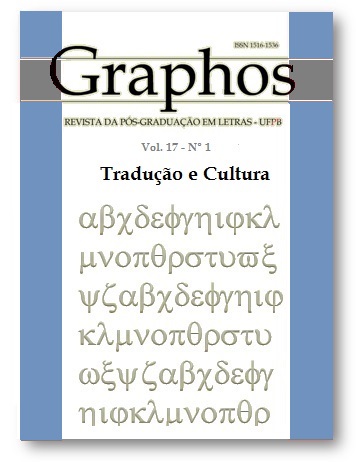A configuração do tempo e da memória no romance e na adaptação fílmica de To the Lighthouse
Keywords:
Virginia Woolf, Time and memory, AdaptationAbstract
The adaptation of subjective categories from literature to cinema has shown large investment in symbolic elements on the plastic language, offering subsidies to a poetical recreation of thematic and temporal spheres. This recreation, according to Chatman (1990), is possible through the filters that maintain the necessary subjectivityto the adaptation of interior perception processes. In this way, our research presents the results of a comparative study between the novel To the Lighthouse, by Virginia Woolf, and its homonymous filmic adaptation, by Colin Gregg, aiming theconstruction of temporal structures analysis, in both narratives, and the meaning effects investigation resulting from the dialogue between the medias. For that, anchored on the critical, theoretical and methodological studies by Hutcheon (2011), Ricoeur (2010), Martin (2007), Draaisma (2005), Bergson (2006), Hussey (2000), Marcus (1997), among other authors, we show the strategies construction that interfere on time and memory configuration significantly, their subjective constraints and symbolic representation. We observe that memory materialization process, on the novel adaptation, is mainly made of symbolic elements related to the interior perception duration, when accessed through a sensorial stimulus, bringing to spectator the possibility of the temporal constraints contemplation and its meaning construction.
Downloads
References
BEER, Gillian. Virginia Woolf: The Common Ground. Michigan, University of Michigan Press, 1996.
BENJAMIN, Walter. Magia e técnica, arte e política: ensaios sobre literatura e história da cultura. São Paulo: Brasiliense, 1994.
BERGSON, Henri. Matéria e memória: ensaio sobre a relação do corpo com o espírito.Trad. Paulo Neves. São Paulo: Martins Fontes, 2006.
_____. Duração e simultaneidade. Trad. Claudia Berliner. São Paulo: Martins Fontes, 2006.
CHATMAN, Seymour. Coming To Terms: The Rhetoric of Narrative in Fiction and Film. Ithaca and London: Cornell University Press, 1990.
DRAAISMA, Douwe. Metáforas da memória: uma história das ideias sobre a mente. São Paulo: EDUSC, 2005.
DELEUZE, Gilles. A imagem-tempo. Trad. Eloisa A. Ribeiro. São Paulo: Brasiliense, 2007.
Revista Graphos, vol. 17, n° 1, 2015 | UFPB/PPGL | ISSN 1516-1536 1 90
GAY, Jane de. Virginia Woolf’s Novels and the Literary Past. Edinburgh: Edinburgh University Press, 2006.
HUSSEY, Mark. How Should One Read a Screen? In: CAUGHIE, Pamela L. (Ed.). Virginia Woolf in The Age of Mechanical Reproduction. New York: Garland Publishing Inc., 2000.
HUTCHEON, Linda. A Theory of Adaptation. New York, Routledge, 2006.
MAFFESOLI, Michel. O instante eterno: o retorno do trágico nas sociedades pós-modernas. Trad. Rogério de Almeida e Alexandre Dias. São Paulo: Zouk, 2003.
MARCUS, Laura. The Tenth Muse: Writing About Cinema in the Modernist Period. USA: Oxford University Press, 2007.
MARTIN, Marcel. A linguagem cinematográfica. Trad. Paulo Neves. São Paulo: Braziliense, 2007.
MEPHAM, John. Figures of Desire: Narration and Fiction in To the Lighthouse. In: REID, Sue (Ed.). Mrs Dalloway and To the Lighthouse: Contemporary Critical Essays. London: Macmillan Press, 1993.
RICOEUR, Paul. Tempo e narrativa: A configuração do tempo na narrativa de ficção. Trad. Márcia Valéria Martinez de Aguiar. São Paulo: Martins Fontes, 2010.
ROSENFELD, Anatol. Os gêneros épico e lírico e seus traços estilísticos fundamentais. In: _____. O teatro épico. São Paulo: Perspectiva, 2008.
WALKER, David. Andre Gide. London: Macmillan, 1990.
WOOLF, Virginia. To The Lighthouse. London: Penguin Books, 1992.
XAVIER, Ismail. O discurso cinematográfico: a opacidade e a transparência. São Paulo: Paz e Terra, 2005.
FILMOGRAFIA
VIRGINIA WOOLF’S TO THE LIGHTHOUSE. Direção: Colin Gregg. Produção: BBC-TV e Colin Gregg Films LTD, 1983. DVD (115 min), Widescreen, color, sem legendas. Distribuição: Monterey Media Inc.







